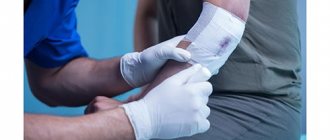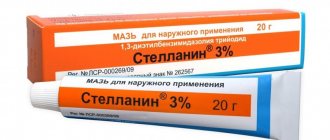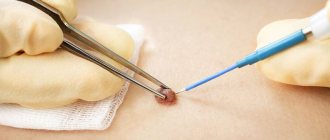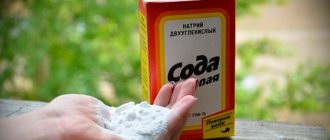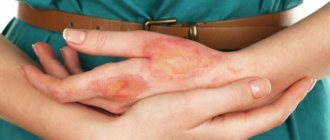What are moles and why do they appear?
Moles or, in medical terms, nevi appear as a result of the accumulation of pigment (melanin) in skin cells. They can come in various sizes, colors and shapes.
There are congenital and acquired moles. Congenital moles begin to appear in the first years of life and have virtually no risk of degeneration into a malignant tumor.
Nevi that appear during puberty, hormonal surges or under the influence of ultraviolet radiation are considered acquired. Such moles are more prone to degeneration and require close attention.
Not everything is a mole that is called this word
Let's agree right away: doctors do not use the term “mole,” and if they do, it is only for the convenience of untrained people. And people without medical education call completely different formations moles: from pigmented nevi to keratomas, from vulgar warts to dangerous tumors.
The word “mole” comes from the phrase “birthmark”. Moles or birthmarks may be barely noticeable: 1 mm in diameter or even less. There are also large formations: several tens of centimeters.
A person without medical education cannot reliably determine what kind of formation he observes on his skin. Just to make sure of this, pay attention to several types of formations that can be seen.
Nevus We most often call this formation a “mole”. This formation is light brown or even reddish to black. It may protrude above the skin or be flat. The size usually does not exceed a few millimeters. But there are giant nevi, the size of which amounts to tens of centimeters. Keratoma is a gray to dark brown plaque or nodule protruding above the skin level. Typically, keratomas are dense to the touch and may crumble. Vulgar warts Flesh-colored plaques protruding above the skin level. They are most common on the palms and soles of the feet, but can appear on any part of the body. They are of viral origin. Papillomas Another formation of a viral nature. It looks like a cauliflower-shaped growth on a thin stalk. Found on any part of the body. Hemangioma Vascular formation. The size varies from 1 mm to several tens of centimeters. May have different shades of red. Flaming nevus or nevus of Unna Another vascular formation. It is also called wine nevus due to its characteristic color.
This is only a small part of the formations that are found on human skin. Very often they are similar to each other. Moreover, even a doctor sometimes cannot distinguish one formation from another without a special device called a dermatoscope. We'll talk about it later, but for now let's answer an important question.
How to identify a malignant mole?
A simple reminder called “ACORD of melanoma” will help to identify signs of degeneration of a benign mole:
- A – asymmetry ;
- K – contour (fuzzy, blurry, uneven);
- O – color (any changes);
- P – size (changes in size in adulthood);
- D – dynamics (appearance of crusts, cracks, peeling, bleeding, sudden disappearance of a mole).
The detection of even one of the five signs listed above is a reason for a visit to a dermatologist, who, through a survey and examination, will help make the correct diagnosis.
Melanoma, located at the level of the superficial layers of the skin, is not dangerous and is completely curable, but if it is allowed to grow deeper, tumor cells will spread through the blood and lymph throughout the body, forming metastases in the internal organs. Mortality in such cases reaches 50%.
What does melanoma look like?
As noted above, in the early stages, a deadly tumor may look like an ordinary “mole” and may not attract the attention of people without medical education. However, there are signs of melanoma that everyone can and should remember. Dermato-oncologist Dmitry Beinusov told MUEHLE Russia readers about these signs.
Dmitry Beinusov
Reference: Dmitry Sergeevich Beinusov, Candidate of Medical Sciences, dermato-oncologist, member of the European Society of Surgical Oncology. Works in St. Petersburg.
People without medical education call completely different formations moles. Some of them are harmless, some are potentially dangerous. Unfortunately, people can mistake a “mole” for a deadly tumor: melanoma. The question is: can an ordinary person, without consulting a specialist, find out exactly what formations are on his face, and whether they pose a danger?
To easily determine the potential danger of a mole, there is the acronym ACCORD (analogous to the English ABCDE):
- A - asymmetry - it is impossible to draw an axis of symmetry through a mole.
- K - the edge has become jagged or scalloped.
- K - bleeding of a mole without external influence.
- O - the color has become uneven, black, red or white has appeared.
- P - the size has increased and become more than 6 mm.
- D - dynamics - hair loss from the mole, disappearance of the skin pattern, persistent redness, the appearance of a glossy sheen or dry crusts.
If your mole meets at least one of these points, it is worth showing it to a dermato-oncologist. Unfortunately, even knowledge of this rule cannot reduce to zero the risk of missing melanoma. Because of this, I recommend that all people undergo a complete examination of all moles on their skin by a specialist at least once a year.
Visualization of signs of melanoma: photo from Toowong Dermatology website
People are afraid of moles because many have heard about melanoma. Is it true that this tumor can also develop on skin areas without moles?
According to one large study from 2022, melanoma develops against the background of unchanged skin in 70% of cases. In the remaining 30%, the tumor develops against the background of moles.
Is it true that a deadly melanoma tumor can look atypical, not like a mole? And I also heard that there are other potentially dangerous tumors on the face, which most people do not pay attention to at least in the first stages of development?
Yes this is true. However, you should not fall into paranoia on this basis. These tumors can also pretend to correspond to one of the points of the ACCORD rule (see above).
Why can't you remove moles?
It is not recommended to comb, cut or rip off nevi, since damage to a benign mole can lead to infection and the development of a tumor. If this does happen, it is necessary to treat the injury site with an antiseptic and stop the bleeding.
The torn mole should be taken to a histology laboratory for examination. If the mole is only partially damaged, you need to pay attention to whether it has changed its color, shape or size after the injury.
Doctors advise removing nevi if, due to their location, they are susceptible to accidental injury and rubbing, as well as in case of suspected degeneration. It is also possible to remove moles for aesthetic reasons.
How to shave if you have moles on your face: recommendations from a dermato-oncologist
Dmitry Beinusov told MUEHLE Russia readers how to shave if there are moles on your face, and what to do if you cut something while shaving.
Many men have moles on their faces. Does this mean that men who shave (do not grow a beard and mustache) need to pay special attention to moles? After all, they are injured to one degree or another during shaving.
I will assume that the question is caused by the widespread opinion on the domestic Internet that injury to moles (nevi) can lead to skin cancer (melanoma).
Indeed, there are studies in which the authors put forward such a hypothesis. These works are based on the results of a survey of patients with skin cancer (melanoma). Some of the respondents whose neoplasm developed against the background of a mole noted previous trauma. Unfortunately, based on these data, it cannot be unequivocally stated that mechanical trauma to a nevus increases the risk of developing skin cancer (melanoma). The fact is that the transformation into cancer could occur both before the injury and after, for completely different reasons.
Studies that refute the statement “mole trauma = cancer” are more convincing, in my opinion. Scientists observed patients whose moles, according to histological examination, were not completely removed, that is, they were injured. This means that part of the nevus was removed and the other part was left in the skin. Observation lasted in some cases up to 20 years. Its results did not show an increased risk of melanoma at the sites of removal in any of the studies.
Thus, we can confidently say that trauma to a mole does not increase the risk of developing melanoma (skin cancer).
In my opinion, if the mole is flat and does not protrude above the skin, it should not cause inconvenience when shaving. If the mole rises above the level of the skin and there is no way to avoid damaging it, then perhaps it is better to remove the formation.
How to shave if a person has a mole on his face? Try not to run a razor over it or not pay attention to the mole? In this case, should it be taken into account that the mole protrudes above the skin or is flat?
In my opinion, if the mole is flat and does not protrude above the skin, it should not cause inconvenience when shaving. If the mole rises above the level of the skin and there is no way to avoid damaging it, then perhaps it is better to remove the formation. My recommendation is not related to the risk of developing skin cancer (melanoma), but rather is dictated by considerations of convenience. When removing, I strongly recommend conducting a histological examination of the mole.
Let me clarify the previous question: if hair grows from a flat mole on the face, can it be shaved? And if hair grows from a raised mole, how to remove it?
You can shave with confidence. Removing with tweezers, in my opinion, is more reliable from the point of view of minimal trauma to the mole itself.
What to do if, while shaving, a person injured some kind of formation, a “mole”? How to treat it, do I need to immediately go to a specialist and remove the formation? What algorithm of actions should you follow?
The most important question in this situation is whether everything was okay with the mole before the injury? Unfortunately, the swelling, redness, and tenderness that occurs after an injury makes it difficult to answer this question. This is why I don’t see much point in an emergency trip to the doctor. If a mole bleeds after injury, you should use hydrogen peroxide. To further reduce the symptoms of inflammation, I usually recommend compresses with available antiseptics, such as chlorhexidine or miramistine.
In most cases, after 5-10 days of using compresses, the mole returns to its original state and can be shown to a specialist. At the same time, it is worth checking other moles on the skin. If this does not happen and the symptoms of inflammation do not go away within several weeks, you need to see an oncologist in person. This is because persistent inflammation can be one of the signs of melanoma (skin cancer).
Is it true that injuries to moles, including razor cuts, are not the most dangerous risk factor for developing melanoma? I heard that there is a more important provoking factor that we are not used to paying attention to. But which we encounter every day, at least during the warm season?
This factor is exposure to ultraviolet radiation. In order to protect yourself as much as possible from it, in the summer and, especially, on vacation in southern latitudes, you should follow simple rules:
- From 10 a.m. to 4 p.m., stay in the shade, as at this time even sunscreen with a high protection factor (SPF 50) may not protect against sunburn.
- Wear a hat with a brim that covers both the face and neck, as well as sunglasses.
- If possible, cover as much of your skin as possible with UV-resistant clothing.
- During prolonged exposure to the sun, apply cream with SPF 50 to all exposed skin.
It may be objected that following these rules in general and applying sunscreen in particular can interfere with the production of vitamin D. I can confidently answer that, according to several studies, the use of these products does not lead to a deficiency of this important vitamin.
I also think it’s important to note that regular use of a solarium is also a proven risk factor for the development of melanoma. This risk increases in direct proportion to the amount of time a person spends under tanning lamps throughout his or her lifetime.
Every May, doctors conduct a campaign for the prevention and early detection of melanoma. As part of the campaign, doctors urge people to visit a doctor and undergo a preventive examination. How often do you need to undergo such examinations, and what specialty doctors should you contact? How long does the inspection take? Isn't it painful or harmful?
Recently, many countries (including us) have been celebrating Melanoma Diagnosis Day. On this day, dermatologists and oncologists examine moles using a dermatoscope for everyone free of charge. In Russia this year the event was held on May 21, 2018.
Dermatoscopy is a quick (no more than 10-15 minutes), absolutely harmless, painless and very accurate method of examining formations on the skin. Whether you choose to have your moles examined as part of Melanoma Diagnosis Day or just come in for a routine appointment, always show all moles on all of your skin. I recommend this because more than once in my practice there have been cases when the tumor that the patient came with turned out to be malignant.
Thank you very much for the very important information!
Please, I wish the readers good health.
When you need to see a doctor urgently
An injured neoplasm requires increased attention and urgent medical care in the following situations:
- during the healing process, the birthmark becomes asymmetrical with uneven boundaries,
- the wound bleeds for a long time,
- the appearance of itching in the area of the nevus,
- active hair growth on a mole after a cut,
- increase in the diameter of the birthmark,
- change in color of a mole from light to dark.
First aid for damage to a vascular formation
The cause of damage to angiomas on the face or body is usually a person’s carelessness during hygiene procedures and changing clothes. Any mole can be accidentally torn off or cut when shaving, using a washcloth, or rubbed by the seams of clothing, a chain or other accessory.
If a red mole bursts or comes off, the first thing you need to do is stop the bleeding. There are many blood vessels in this area, so the wound may bleed heavily and for a long time. To prevent the development of complications:
- treat the damaged area with any alcohol-free antiseptic,
- cover with a sterile plaster or bandage.
Before contacting a specialist, you should not apply any ointments or gels to the wound.
How to properly disinfect a wound
After cutting off a mole, it is difficult to predict what will happen next. Much depends on immunity and heredity. But treating the wound with antiseptics plays a big role. This will definitely prevent inflammation of the injured area. This is especially important to do if there is a wound in the bikini area.
Suitable for disinfection:
- Miramistin solution. This is one of the most powerful antiseptics. But at the same time, it acts on the wound surface of the mucous membranes very gently and has no side effects.
- Aqueous or alcoholic solution of Chlorhexidine. Do not use an alcohol-based product for treatment in the bikini area.
Hydrogen peroxide is not entirely suitable as an antiseptic, so it is better to use the drug to stop bleeding after an injury.
What should you not do?
If, during the process of removing excess hair on the body, a nevus was accidentally cut, then it is strictly forbidden to take the following actions:
- try to remove the growth yourself;
- apply any non-traditional methods of treatment;
- pick out frozen blood;
- peel off the crust formed during healing;
- wash the wound with running water;
- treat the cut with healing ointments or creams;
- leave the wound open.
If a mole or part of it was cut off during shaving, then you do not need to throw away the torn tissue, but rather place it in a rag soaked in saline solution and take it to the clinic for histological examination. Also, damage to the nevus should not be left unattended. Improper care of the affected growth and negligent attitude towards one’s health can cause the formation of a cancerous tumor and other serious complications.
Prevention measures
If a man has a raised mole on his face, which is constantly at risk of cuts and injuries, preventive measures must be taken. You should not delay this and underestimate the danger of damage to the nevus, since almost every man is at risk of developing melanoma. To protect moles from cuts and scratches you should:
- reduce contact with animals that can scratch the mole;
- if there are raised moles on the face and body, it is advisable to remove them with the hands of a specialist;
- avoid friction with synthetic fabrics;
- protect moles from contact with nails;
- Shave your face carefully;
- avoid prolonged direct exposure to sunlight;
- Avoid squeezing moles with shoes if they are on your feet.
But the most competent step to prevent melanoma is to consult a dermatologist and remove the nevus with melanin. Especially if the mole is on the face of a man who regularly shaves his stubble, the risks of injury are as high as possible.
Ways to remove a mole
If a man has a mole on his face that has been repeatedly injured during shaving and other hygiene procedures, a specialist usually decides to remove it. Modern medicine offers several options for nevus removal, namely:
- freezing the nevus and its processes with liquid nitrogen;
- removal of a nevus using a laser device;
- removal of a nevus by exposure to radio waves or electric current;
- removal through surgery in particularly difficult situations.
For each patient, the doctor determines an individually appropriate method for removing the nevus, taking into account his body characteristics, health status and genetic predispositions. But before carrying out such a procedure, the patient should be familiar with the disadvantages and advantages of each technique. The most commonly used method is nitrogen and laser removal.
How to prevent cuts
Like any problem, nevus cutting is best prevented. Large convex formations pose a danger. Therefore, it is better to consult a doctor before mechanical damage occurs. After examining the nevus, he will tell you whether it can be removed.
Before this, you need to follow simple recommendations:
- choose clothes to wear without rough seams to reduce friction,
- shaving is carried out carefully, avoiding the area where the mole is located,
- do not scratch the birthmark,
- When playing with pets, care should be taken to avoid scratching the site of the nevus.
Moles that are injured more than once are best removed as quickly as possible. Even with a benign form of the neoplasm, wound infection can occur, so you should not ignore the situation, it is better to consult a doctor.

